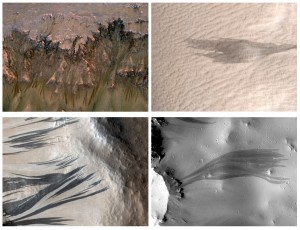Slopes, Streaks and Flows
/https://tf-cmsv2-smithsonianmag-media.s3.amazonaws.com/filer/20111214123013moon-streaks.jpg)
Although the Moon’s gravity is low, only about 0.165 of the Earth, rock and soil move down slope over time. In geology, such processes are called mass wasting and is one of the principal sources of erosion on the Moon (the other being meteorite bombardment). Mass wasting includes both gradual, infinitesimally slow soil creep on slopes and rapid, catastrophic mass movements, called landslides. Long trains of rock debris can form scree slopes, loose fragments lying precariously at the critical angle beyond which they move, the angle of repose. Because impact craters make steep walls and the larger ones bring up peaks in their centers, most mass wasting on the Moon is found in and around impact craters of all sizes.
As the number of high resolution images taken from the LRO mission continues to proliferate, several interesting and underappreciated lunar surface phenomena are becoming more apparent. Among the fresh craters of the Moon, we find light and dark steaks on the walls of the ubiquitous craters of the Moon. Although it is not surprising that material might move or flow down steep slopes on the Moon, the appearance of these flows can be startlingly similar to those seen on other planets, particularly Mars, where such streaks have been cited as evidence for the presence of subsurface water.
The new narrow angle LRO camera can see objects on the surface smaller than one meter (typically, 50 cm per pixel resolution). These new views have shown us a wide diversity of new features within impact craters and have given us a new appreciation for mass wasting. Larger crater walls are slumped, with stair step-like wall terraces, concentrically arranged around the crater between rim and floor. In detail, these terraces show ponds of dark material that seem to collect in low areas. Most of this material looks like it was once molten but now congealed; it is probably solidified impact melt. Flows of melt may cascade down and over the walls of fresh craters.
However, many “flows” of both dark and light material on the Moon seem to consist of loose fragments of rock debris lying on steep slopes. These debris flows show a variety of morphologies, including simple flow shapes, cascades, ponding, and fan-like termini. Sometimes the dark and light flows intermingle within a single crater while others show only one type. These debris flows can usually be traced back to outcrops of bedrock in the upper portions of the crater wall. As the bedrock erodes (usually by meteorite erosion and disaggregation due to the intense fracturing induced by the original impact that formed the crater), it sheds small fragments that train down slope, forming flow-like landforms.
Because crater walls are uneven, undulating surfaces, the rates of down slope movement can vary widely over small distances. This sometimes results in multiple, overlapping flows of debris. Factors that control the albedo (reflectivity) of the debris flows are not well understood. It could be related to composition (for example, dark, iron-rich mare basalt vs. white, anorthositic highland rocks). Another factor might be particle size; small pebble-sized rock flows could be bright as new, fresh surfaces are constantly exposed. Flows that contain mixed soil might be darker than normal, as this soil could cover the fragments and reduce its average reflectivity. But while all these factors may be of significance to one degree or another, the brightness of a streak is not particularly indicative of origin.
On Mars, many dark streaks are evident on crater walls and, as on the Moon, come in a wide variety of forms and occurrences. Martian dark streaks have been variously interpreted as being caused by compositional and particle size differences, but the most popular idea is that the dark streaks are wet soil, i.e., they represent areas where liquid water is seeping out from the planet’s subsurface and moistening the surface. One observation supporting this idea is an apparent correlation of some of the dark streaks with surface temperature, with warmer slopes showing more. As liquid water is not stable on the martian surface, salt-rich brines (which would have much lower melting points than pure water) have been invoked as the possible liquid phase.
The dark streaks on the crater walls of the Moon call water-related interpretations of similar features on Mars into question. The nature of down slope movement on Mars is likely to be controlled by even more diverse factors than the lunar case. For example, large landslides partly cover the floor of the Valles Marineris, the large canyon system on Mars. These landslides can extend tens of kilometers across the valley floor and the mass flow might have been lubricated by trapped atmospheric gas; this “cushioning” effect occurs within some landslides on the Earth. Such a process would not occur on the Moon. The diversity of geological processes on Mars suggests that explanations for dark wall streaks could encompass many more possibilities than simple wetting of the surface.
Although the existence of dark lunar streaks does not negate water-related interpretations of similar features on Mars, they do call attention to the need to keep alternative hypotheses in mind. For many years (and with some success), planetary geologists have extrapolated landforms and processes (thought to be understood) on Earth, to similar appearing features on the planets. In the case of the dark streaks, terrestrial water seepages in the desert can be darker than surrounding desiccated terrain. A wide variety of evidence indicates that water is present in the subsurface on Mars but sometimes other effects such as rock composition or particle size are responsible for the streaks and alternatives to seepage should always be kept in mind.
Planning Your Next Trip?
Explore great travel deals
Smithsonian magazine participates in affiliate link advertising programs. If you purchase an item through these links, we receive a commission.
